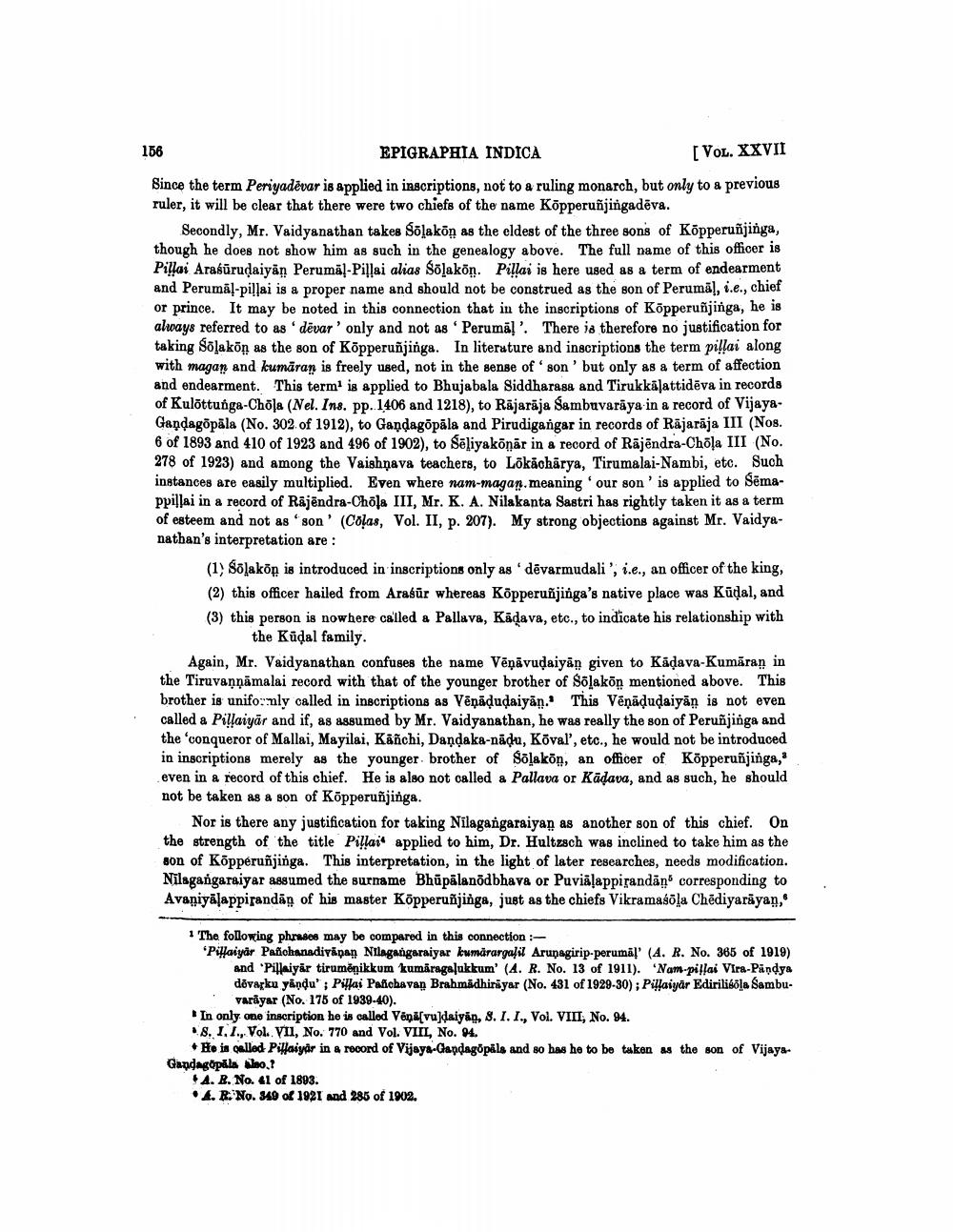________________
156
EPIGRAPHIA INDICA
[VOL. XXVII
Since the term Periyadēvar is applied in inscriptions, not to a ruling monarch, but only to a previous ruler, it will be clear that there were two chiefs of the name Kõpperuñjingadēva.
Secondly, Mr. Vaidyanathan takes sõlakon as the eldest of the three sons of Kõpperuñjinga, though he does not show him as such in the genealogy above. The full name of this officer is Pillai Arabūrudaiyãn Perumal-Pillai alias Sõlakon. Pillai is here used as a term of endearment and Perumal-pillai is a proper name and should not be construed as the son of Perumā), i.e., chief or prince. It may be noted in this connection that in the inscriptions of Köpperusjinga, he is always referred to as dëvar' only and not as 'Perumal'. There is therefore no justification for taking Sõlakon as the son of Köpperuñjinga. In literature and inscriptions the term pillai along with magan and kumāran is freely used, not in the sense of son' but only as a term of affection and endearment. This term is applied to Bhujabala Siddharasa and Tirukkāļattidēva in records of Kulõttunga-Chola (Nel. Ins. pp. 1406 and 1218), to Rājarāja Sambuvarāya-in a record of VijayaGandagõpāla (No. 302 of 1912), to Gandagõpāla and Pirudigangar in records of Rājarāja III (Nos. 6 of 1893 and 410 of 1923 and 496 of 1902), to Sēliyakönār in a record of Rājēndra-Chēļa III (No. 278 of 1923) and among the Vaishnava teachers, to Lõkáchārya, Tirumalai-Nambi, etc. Such instances are easily multiplied. Even where nam-magan, meaning our son' is applied to Sēmappillai in a record of Rājēndra-Chõla III, Mr. K. A. Nilakanta Sastri has rightly taken it as a term of esteem and not as son' (Colas, Vol. II, p. 207). My strong objections against Mr. Vaidyanathan's interpretation are :
(1) Solakóp is introduced in inscriptions only as 'dēvarmudali', i.e., an officer of the king, (2) this officer hailed from Aragūr whereas Kõpperuñjinga's native place was Kūdal, and (3) this person is nowhere called a Pallava, Kādava, etc., to indicate his relationship with
the Kūdal family. Again, Mr. Vaidyanathan confuses the name Vēņāvudaiyān given to Kādava-Kumāran in the Tiruvannamalai record with that of the younger brother of Sölakon mentioned above. This brother is unifo:mly called in inscriptions as Vēņādudaiyan. This Vēņādudaiyan is not even called a Pillaiyar and if, as assumed by Mr. Vaidyanathan, he was really the son of Peruñjinga and the 'conqueror of Mallai, Mayilai, Kanchi, Dandaka-nādu, Kõval', etc., he would not be introduced in inscriptions merely as the younger brother of Solakön, an officer of Kõpperuñjinga, even in a record of this chief. He is also not called a Pallava or Kadava, and as such, he should not be taken as a son of Köpperuñjinga.
Nor is there any justification for taking Nilagangaraiyan as another son of this chief. On the strength of the title Pillai applied to him, Dr. Hultzsch was inclined to take him as the son of Köpperuñjinga. This interpretation, in the light of later researches, needs modification. Nilsgangaraiyar assumed the surname Bhūpālanodbhava or Puviālappirandān corresponding to Avaniyālappirandān of his master Köpperuñjinga, just as the chiefs Vikramasõla Chēdiyarāyan,
1 The following phrases may be compared in this connection - Pillaiyar Pafiohanadiyapan Nilagangaraiyar kumarargalil Arunagirip-perumal' (A. R. No. 365 of 1919)
and Pillaiyar tirumenikkum kumāragalukkum' (4. R. No. 13 of 1911). 'Nam-pillai Vira-Pandya dövarku yandu'; Piffai Pafichavan Brahmadhiriyar (No. 431 of 1929-30); Pillaiyar Edirilisola Sambu
variyar (No. 176 of 1939-40). . In only one inscription he is called Vēņā[vu]daiyag, 8. 1. I., Vol. VIII, No. 94.
8. 1. 1., Vol. VII, No. 770 and Vol. VIIL, No. 94.
• He is called Pillaiyar in a rooord of Vijaya-Candagöpals and so has he to be taken as the son of VijayaGandagopala slo?
4. R. No. 41 of 1893. • 4. R. No. 349 of 1921 and 285 of 1902.




